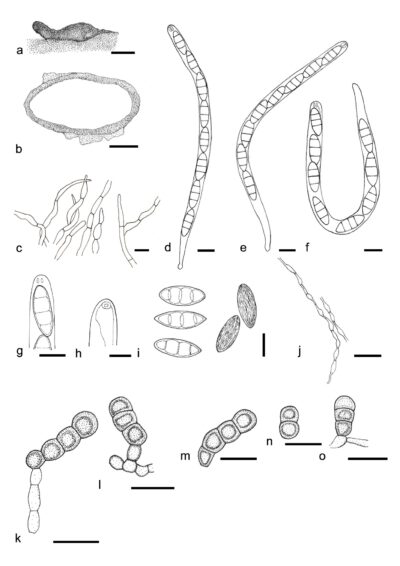Fungalpedia – Note 292, Atractospora
Atractospora Réblová & J. Fourn.
Citation when using this entry: Perera et al. 2024 (in prep) – Fungalpedia, genera described in 2016.
Index Fungorum, Facesoffungi, MycoBank, GenBank, Fig. 1
Classification: Atractosporaceae, Atractosporales, Diaporthomycetidae, Sordariomycetes, Pezizomycotina, Ascomycota, Fungi
Réblová et al. (2016) established Atractospora based on LSU, SSU and rpb2 sequence data. In their phylogenetic analysis Atractospora species were nested within Sordariomycetidae without showing affinities to any established order (Réblová et al. 2016). Later, Zhang et al. (2017) introduced Atractosporaceae (and Atractosporales) was to include Atractospora and Rubellisphaeria based on LSU-SSU-ITS-rpb2 phylogenetic analysis by Atractospora is characterized by astromatic, perithecial ascomata that are immersed to semi-immersed in the decaying wood. Ascomata are horizontally positioned on the host, dark brown, subglobose to conical, and have a lateral neck and a periphysate ostiole. Ascomatal wall is two-layered and leathery to fragile. Asci lying with numerous, persistent and septate paraphyses. They are unitunicate, 8-spored and stipitate with a non-amyloid apical annulus at the apex. Ascospores are hyaline, fusiform, aseptate or transversely septate, thick-walled, smooth or ornamented, without sheath or appendages. The asexual morph is undetermined (Réblová et al. 2016). However, intercalary or terminal asexual structures produced from vegetative mycelium of Atractospora decumbens were reported by Réblová et al. (2016). They were described as brown, ellipsoidal to subglobose, aseptate and thick-walled cells often forming chains of three to five cells (Réblová et al. 2016). However, these were not considered as asexual morph of A. decumbens by the authors (Zhang et al. 2017). To date the genus accomodates seven species that are saprobic on decaying wood submerged in freshwater environments (Réblová et al. 2016; Zhang et al. 2017, 2023).
Type species: Atractospora reticulata Réblová & J. Fourn.
Other accepted species: Species Fungorum – search Atractospora
Figure 1 – Atractospora reticulata (a–i: PRM 934677, holotype; j: CBS 127884, ex-type strain). and Atractospora decumbens (k–o: CBS 139032, ex-type strain). a Ascomata on decorticated wood. b Vertical section of the ascoma. c Paraphyses. d–f Asci with ascospores. g, h Apical annulus. i Ascospores. j Moniliform hyphae in vitro. k–o Thick walled, dark brown cells arising blastically from vegetative mycelium. Scale bars: a = 250 μm, b = 50 μm, c–o = 10 μm. Redrawn from Réblová et al. (2016).
References
Entry by
Rekhani Hansika Perera, Center of Excellence in Fungal Research, Mae Fah Luang University, Chiang Rai, 57100, Thailand.
(Edited by Kevin D. Hyde, Samaneh Chaharmiri-Dokhaharani, & Achala R. Rathnayaka)
Published online 8 July 2024
